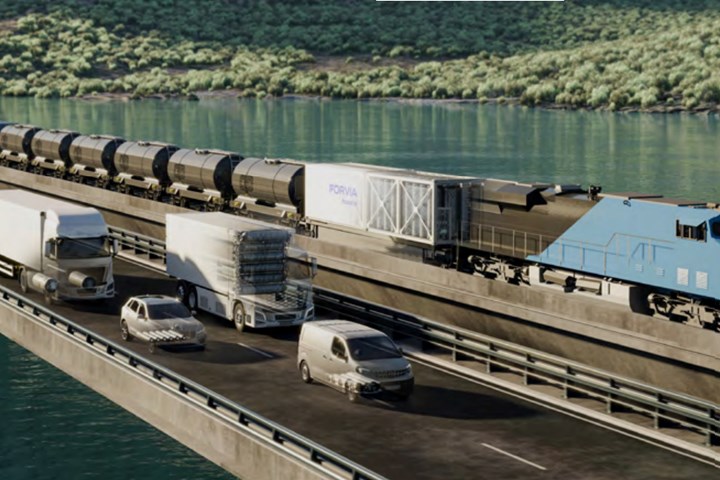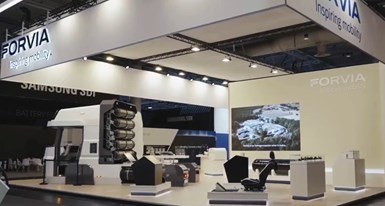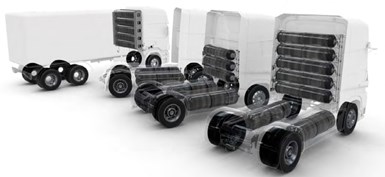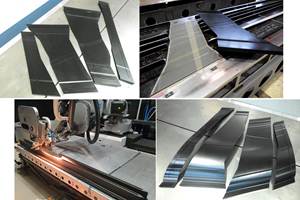Forvia brand Faurecia exhibits XL CGH2 tank, cryogenic LH2 storage solution for heavy-duty trucks
Part of its full hydrogen solutions portfolio at IAA Transportation 2022, Faurecia also highlighted sustainable thermoplastic tanks and smart tanks for better safety via structural integrity monitoring.
Forvia (Nanterre, France) is reportedly the world’s seventh largest automotive technology company, comprising the Faurecia and Hella brands. In its Sept. 19 press release and IAA Transportation 2022 press kit, Forvia describes its developments and strategy for enabling the clean mobility transition. Forvia’s display at IAA Transportation 2022 (Hanover, Germany, September 20-25, 2022) included various hydrogen (H2) drivetrain and storage solutions, including hydrogen storage tanks using thermoset and thermoplastic composites.
In terms of heavy-duty fuel cell vehicles, Forvia reports it is able to provide to its customers the full hydrogen drivetrain, including a complete 700 bar H2 storage system (storing up to 80 kilograms of compressed gaseous hydrogen, CGH2) and Symbio’s 150-kilowatt fuel-cell stack. This storage is achievable by combining five Type IV CGH2 tanks in a behind-the-cab module and two maximized side-mounted XL tanks (700 millimeters in diameter and 2,500 millimeters long).
Forvia also introduced, for the first time, its Cryogenic Hydrogen Storage solution developed by Faurecia, highlighting the innovative capabilities of the company. Leveraging the higher energy density of liquid hydrogen (LH2), Forvia and Faurecia reportedly offer a compact storage solution that enables the same quantity of H2 to be stored within a 40% reduced volume (versus 700-bar CGH2 tanks), facilitating vehicle integration and maximizing the quantity of H2 onboard. It is suited for intensive usage (low idle time) and large autonomy (long driving times without stopping) of up to 1,000 kilometers. This subcooled liquid hydrogen (sLH2) storage system is co-developed with Air Liquide (Paris, France).
The company also exhibited both sustainable and smart tanks, explaining in its press release: “These innovations will enable both recyclable tanks, with thermoplastic [composite] solutions, and safety enhancement through structure integrity monitoring.”
Additionally, Forvia presented its containerized H2 storage solution, adapted for industrial applications and fleet management, including H2 transportation and distribution (refueling stations). By providing these lightweight and competitive solutions to H2 ecosystems worldwide, Forvia says it is reinforcing its position as a key player in the H2 value chain and enabler of clean mobility.
XL-tanks for HD trucks
Forvia stressed its commitment to sustainable mobility and noted its position as a pioneer in H2 trucks, reportedly equipping the first H2 truck in the world, Hyundai’s (Seoul, South Korea) X-Cient, on the road since 2021 using Faurecia’s 350- bar Type IV CGH2 storage tanks. To maximize driving range and to comply with higher pressure needs, Forvia reports Faurecia has developed 700-bar tanks for truck applications which deliver almost 80% higher H2 capacity than 350 bar tanks.
The new XL-Type IV composite tanks have been developed to comply with side- and belt-mounted installation, sized with an external diameter of 550 to 700 millimeters and length up to 2,500 millimeters with a storage weight ratio (mass of H2/mass of storage tank) of more than 7% at 700 bar pressure.
XL-tanks can be installed alone or in groups and in combination with a vertical storage system mounted behind the truck cabin, in the case of U.S. truck configurations, for example. These tanks extend Faurecia’s already established capability in Type IV carbon fiber-reinforced polymer (CFRP) tanks for light commercial vehicles (Forvia supplies the complete hydrogen system for Stellantis’ Opel Vivaro which is on the road since 2021) and trucks (Forvia supplies the complete hydrogen storage system for Hyundai X-Cient since last year).
LH2 as option in storage portfolio
In its Sept. 6, 2022 online co-written article, “Hydrogen mobility for heavy-duty: Air Liquide and Faurecia are on the case!”, Air Liquide (Paris, France) and Faurecia note that heavy-duty truck transportation accounts for 6% of CO2 emissions. Since LH2 is twice as dense as CGH2 (at 350 bar), it allows much more fuel to be stored onboard — up to 80 kilograms for a range of up to 1,000 kilometers. “Faurecia already supplies heavy-duty vehicle manufacturers with gaseous hydrogen,” explains Pauline Chartier, director of strategy and partnerships at Faurecia. “What we are looking for with Air Liquide is to add liquid hydrogen to our portfolio of hydrogen storage solutions, which will of course increase vehicle range, while also maintaining the flexibility that is currently provided by combustion-based solutions.” The latter include internal combustion engines (ICEs) being commercialized by a number of companies worldwide, such as Cummins (Columbus, Indiana, U.S.).
By 2030, Forvia estimates that over 20% of annual H2 vehicle production will be commercial vehicles (excluding light commercial vehicles). In an October 2021 press release, Faurecia announced its partnership with Air Liquide to develop LH2 storage. Air Liquide’s online article, co-written with Faurecia, states that the sLH2 tank developed with Faurecia, currently in the prototype phase, is scheduled “to hit the market in 2027.” Challenges for both partners to overcome during this time period, the article explains, include “standardizing the dedicated LH2 supply chain (stations, connectors, tanks, etc.) and scaling up a highly complicated technology (creating and maintaining a vacuum in the tanks, initiating large-scale production).”
The partnership aims to produce and market tens of thousands of tanks and install them in vehicles by 2030. To meet the world’s goals for reduced CO2 emissions, a sufficiently large portion of the heavy-duty transportation market must convert to zero-emissions technologies, with LH2 a well-suited option.
But the technology is still at a relatively low level of maturity. Faurecia estimates that <5% of hydrogen heavy duty vehicles running on H2 will do so using LH2 by 2035. This percentage should increase significantly, however, beyond 2035.
Subcooled versus cryo-compressed
In Part 2 of the online article titled, “Air Liquide and Faurecia are bringing liquid hydrogen to heavy-duty vehicles,” the two partners explain that the technology being developed will be based on sLH2 at a maximum pressure of about 20 bar in the tank. The temperature range for sLH2 has been defined by another partnership developing this technology — Daimler Truck (Stuttgart, Germany) and Linde (Dublin, Ireland) — as between the LH2 boiling point of -253°C and -245°C, maintained by vacuum and multilayer insulation (MLI) between the inner and outer tanks, with no active (powered) cooling.
Another option is cryo-compressed H2 storage (CcH2), but Air Liquide and Faurecia prefer sLH2, which they say offers a good compromise between user cost, time to market and performance-use balance whereas CcH2, they believe, will be more expensive and take longer to develop.
CcH2 was developed for automotive by BMW (Munich, Germany, reports published from 2006-2013), now carried forward by Cryomotive (Taufkirchen, Germany) using an insulated CFRP tank system. BMW reported using 350-bar pressure and temperature between -233°C and -193°C. Cryomotive plans to store 80 kilograms of H2 in two insulated tanks by either cryo-compressing LH2 or by cryo-cooling gaseous H2 (GH2), delivering GH2 at up to 30 bar for fuel cell and ICE powertrains.
Smart and sustainable CFRP tanks
To meet its goals of being carbon net-zero by 2045 and providing the safest products possible, Forvia reports Faurecia is developing “a smart and sustainable carbon fiber composite structure” combining:
- Upgraded composite with higher mechanical strength and carbon fiber with lower CO2 footprint carbon fiber, enabling up to -30% of CO2 emissions.
- Innovative tank production processes to ensure recyclability.
- Smart sensing system to reinforce safety in use by detection of critical events as well as optimized operating periods and downtimes via tank structural integrity monitoring.
Related Content
Welding is not bonding
Discussion of the issues in our understanding of thermoplastic composite welded structures and certification of the latest materials and welding technologies for future airframes.
Read More3D-printed CFRP tools for serial production of composite landing flaps
GKN Aerospace Munich and CEAD develop printed tooling with short and continuous fiber that reduces cost and increases sustainability for composites production.
Read MorePlant tour: Joby Aviation, Marina, Calif., U.S.
As the advanced air mobility market begins to take shape, market leader Joby Aviation works to industrialize composites manufacturing for its first-generation, composites-intensive, all-electric air taxi.
Read MoreComposites manufacturing for general aviation aircraft
General aviation, certified and experimental, has increasingly embraced composites over the decades, a path further driven by leveraged innovation in materials and processes and the evolving AAM market.
Read MoreRead Next
“Structured air” TPS safeguards composite structures
Powered by an 85% air/15% pure polyimide aerogel, Blueshift’s novel material system protects structures during transient thermal events from -200°C to beyond 2400°C for rockets, battery boxes and more.
Read MoreAll-recycled, needle-punched nonwoven CFRP slashes carbon footprint of Formula 2 seat
Dallara and Tenowo collaborate to produce a race-ready Formula 2 seat using recycled carbon fiber, reducing CO2 emissions by 97.5% compared to virgin materials.
Read MoreDeveloping bonded composite repair for ships, offshore units
Bureau Veritas and industry partners issue guidelines and pave the way for certification via StrengthBond Offshore project.
Read More




















.jpg;maxWidth=300;quality=90)












